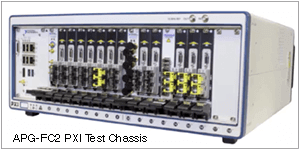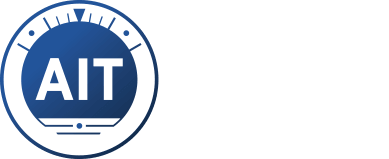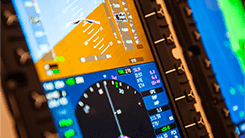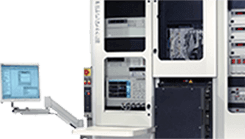- ATE Requirements
- PXIe-based ATE Platforms
- PXIe-based ATE Applications
- Complete ATE Solutions
ATE Requirements for Successful Avionics Interface Test and Simulation.
Capable and cost-effective avionics network and database testing requires more than just a hardware interface and a device driver.
Whether it’s straightforward I/O tests of ARINC 429 and MIL-STD 1553 or sophisticated network testing for Fibre Channel/HS1760, ARINC 664, or AS6003 TTP, ATE systems from AIT provide a complete test solution.
ATE systems must meet at least six demands:
- Instruments with high bandwidth and channel density required by modern networks such as AFDX/Ethernet and Fibre Channel.
- Instruments with exhaustive error injection and detection to thoroughly test ever-increasing network speeds.
- Instruments available in VXI or PXI—the most widely used ATE system form factors.
- Instruments with onboard intelligence to reduce the host system processing load.
- Software development and operating environments such as LabVIEW™, LabWindows™ and Microsoft Windows™.
- Instruments and software that is fully supportable over the long run to prevent premature ATE system obsolescence.
ATE supplied by AIT meets all these demands.
PXIe-based ATE Platforms Are a Good Choice for Avionics Interface ATE.
The data rates, bandwidth, and error-handling capabilities of today’s—and tomorrow’s—avionics networks will just keep increasing.
The test engineer’s challenge is implementing ever higher performance ATE that not only keeps up, but anticipates these advances—and doing it at reasonable cost.
Modern avionics interface ATE system requirements include:
- Accurate data logging with precise time-stamping with sub-µSec precision.
- Time synchronization facilities.
- Synchronization with external equipment via external trigger inputs/outputs.
- Full error injection & detection.
- Large capacity input/output data buffers.
- Ability to adapt existing protocols as well as meet custom test and simulation requirements.
At the same time, legacy avionics networks such as ARINC 429 and MIL-STD 1553 continue to be widely deployed—and will still need to be tested for the foreseeable future.
The PXI Express (PXIe) backplane and buses as well as its form factor meet these requirements:
- PXIe provides timing and synchronization features required for the test and simulation applications demanded by modern avionics interfaces.
- PXIe includes longstanding system peripheral buses used in existing PCI and PCIe systems providing full backwards compatibility with earlier ATE.

Examples of AIT-supplied PXIe instruments are listed below.
PXI Express
ARINC 664 Part 7 PXI Express Test & Simulation Instrument
PXI Express
Two Port Ethernet Test Instrument for 10 Mbit/s to 1 Gbit/s Ethernet
PXI Express
Fibre Channel PXI Express Test & Simulation Instrument
PXI Express
Two port, high performance, ASM, RDMA, FC-AV, and FC-AE-1553 NIC
PXI Express
ARINC 429 PXI Express Test & Simulation Instrument
Application Examples: PXIe-based Avionics Interface ATE.
PXIe-based ATE is an ideal system for testing avionics buses, gateways, and data acquisition systems.
Testing Avionics Ethernet Switches
Ethernet switches with 16, 24, and 32 ports are common. Also, thorough performance and load testing requires sophisticated synchronization capabilities.
- 18-slot PXIe ATE systems are a good platform choice for testing.
- PXIe triggers available on the system backplane may be used to synchronize data transmission across multiple ports.
Testing Avionics Gateways
Commercial avionics systems typically include ARINC 429 <—> Ethernet Gateways (Data Concentrators). Latency from ARINC 429 to Ethernet is an important test requirement.
- PXIe’s ability to synchronize test instrument clocks allows accurate measurement of latency time of ARINC 429-to-Ethernet signals.
Testing Data Acquisition Systems
Military avionics systems often include multi-bus architectures that may have ten or more MIL-STD-1553 buses—or even hundreds of ARINC 429 channels.
- PXIe ATE systems provide high slot count and bandwidth required to capture avionics data.
- Multiple instrument modules may be synchronized to PXIe reference clocks, enabling accurate time stamping across all interfaces.
- Testing of newer avionics systems that employ Fibre Channel (1, 2, 4 Gbit/sec) and Ethernet (10 Mbit/sec to 10 Gbit/sec) require the high system bus speeds speeds inherent to PXIe-based ATE systems.
Creating Successful Avionics ATE Requires More Than Instruments.
- Instrumentation drivers should employ the Virtual Instrument Software Architecture (VISA) standard, which used across the test and measurement (T&M) industry.
- ATE system programming environments should be compatible with common T&M development environments such as LabVIEW™ and LabWindows™.
- Test instruments must supportable over the long run because ATE obsolescence can impose substantial test bottlenecks and costs. [Link to obsolescence paper…]
- COTS instrumentation that’s rugged and cost-effective.
- Easy software integration and modification.
- Quality that sustains system performance over the long run.
AIT designs and builds complete avionics test and verification systems.










